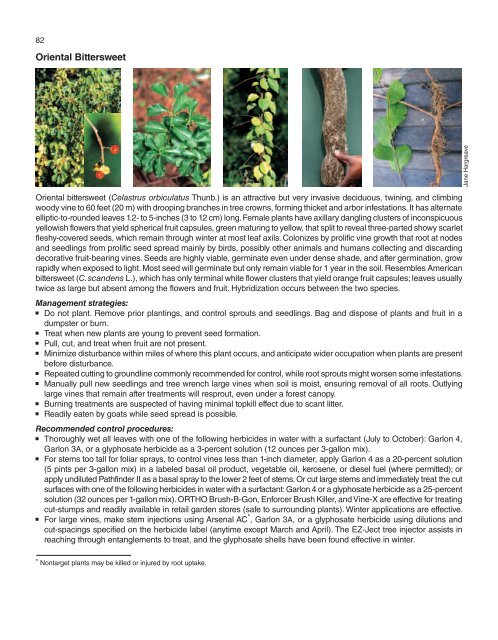A Management Guide for Invasive Plants in Southern Forests James ...
A Management Guide for Invasive Plants in Southern Forests James ...
A Management Guide for Invasive Plants in Southern Forests James ...
- No tags were found...
Create successful ePaper yourself
Turn your PDF publications into a flip-book with our unique Google optimized e-Paper software.
82Oriental BittersweetJane HargreaveOriental bittersweet (Celastrus orbiculatus Thunb.) is an attractive but very <strong>in</strong>vasive deciduous, tw<strong>in</strong><strong>in</strong>g, and climb<strong>in</strong>gwoody v<strong>in</strong>e to 60 feet (20 m) with droop<strong>in</strong>g branches <strong>in</strong> tree crowns, <strong>for</strong>m<strong>in</strong>g thicket and arbor <strong>in</strong>festations. It has alternateelliptic-to-rounded leaves 1.2- to 5-<strong>in</strong>ches (3 to 12 cm) long. Female plants have axillary dangl<strong>in</strong>g clusters of <strong>in</strong>conspicuousyellowish flowers that yield spherical fruit capsules, green matur<strong>in</strong>g to yellow, that split to reveal three-parted showy scarletfleshy-covered seeds, which rema<strong>in</strong> through w<strong>in</strong>ter at most leaf axils. Colonizes by prolific v<strong>in</strong>e growth that root at nodesand seedl<strong>in</strong>gs from prolific seed spread ma<strong>in</strong>ly by birds, possibly other animals and humans collect<strong>in</strong>g and discard<strong>in</strong>gdecorative fruit-bear<strong>in</strong>g v<strong>in</strong>es. Seeds are highly viable, germ<strong>in</strong>ate even under dense shade, and after germ<strong>in</strong>ation, growrapidly when exposed to light. Most seed will germ<strong>in</strong>ate but only rema<strong>in</strong> viable <strong>for</strong> 1 year <strong>in</strong> the soil. Resembles Americanbittersweet (C. scandens L.), which has only term<strong>in</strong>al white flower clusters that yield orange fruit capsules; leaves usuallytwice as large but absent among the flowers and fruit. Hybridization occurs between the two species.<strong>Management</strong> strategies:Do not plant. Remove prior plant<strong>in</strong>gs, and control sprouts and seedl<strong>in</strong>gs. Bag and dispose of plants and fruit <strong>in</strong> adumpster or burn.Treat when new plants are young to prevent seed <strong>for</strong>mation.Pull, cut, and treat when fruit are not present.M<strong>in</strong>imize disturbance with<strong>in</strong> miles of where this plant occurs, and anticipate wider occupation when plants are presentbe<strong>for</strong>e disturbance.Repeated cutt<strong>in</strong>g to groundl<strong>in</strong>e commonly recommended <strong>for</strong> control, while root sprouts might worsen some <strong>in</strong>festations.Manually pull new seedl<strong>in</strong>gs and tree wrench large v<strong>in</strong>es when soil is moist, ensur<strong>in</strong>g removal of all roots. Outly<strong>in</strong>glarge v<strong>in</strong>es that rema<strong>in</strong> after treatments will resprout, even under a <strong>for</strong>est canopy.Burn<strong>in</strong>g treatments are suspected of hav<strong>in</strong>g m<strong>in</strong>imal topkill effect due to scant litter.Readily eaten by goats while seed spread is possible.Recommended control procedures:Thoroughly wet all leaves with one of the follow<strong>in</strong>g herbicides <strong>in</strong> water with a surfactant (July to October): Garlon 4,Garlon 3A, or a glyphosate herbicide as a 3-percent solution (12 ounces per 3-gallon mix).For stems too tall <strong>for</strong> foliar sprays, to control v<strong>in</strong>es less than 1-<strong>in</strong>ch diameter, apply Garlon 4 as a 20-percent solution(5 p<strong>in</strong>ts per 3-gallon mix) <strong>in</strong> a labeled basal oil product, vegetable oil, kerosene, or diesel fuel (where permitted); orapply undiluted Pathf<strong>in</strong>der II as a basal spray to the lower 2 feet of stems. Or cut large stems and immediately treat the cutsurfaces with one of the follow<strong>in</strong>g herbicides <strong>in</strong> water with a surfactant: Garlon 4 or a glyphosate herbicide as a 25-percentsolution (32 ounces per 1-gallon mix). ORTHO Brush-B-Gon, En<strong>for</strong>cer Brush Killer, and V<strong>in</strong>e-X are effective <strong>for</strong> treat<strong>in</strong>gcut-stumps and readily available <strong>in</strong> retail garden stores (safe to surround<strong>in</strong>g plants). W<strong>in</strong>ter applications are effective.For large v<strong>in</strong>es, make stem <strong>in</strong>jections us<strong>in</strong>g Arsenal AC * , Garlon 3A, or a glyphosate herbicide us<strong>in</strong>g dilutions andcut-spac<strong>in</strong>gs specified on the herbicide label (anytime except March and April). The EZ-Ject tree <strong>in</strong>jector assists <strong>in</strong>reach<strong>in</strong>g through entanglements to treat, and the glyphosate shells have been found effective <strong>in</strong> w<strong>in</strong>ter.* Nontarget plants may be killed or <strong>in</strong>jured by root uptake.
















